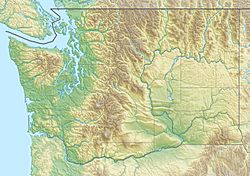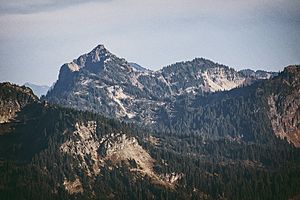Dewey Peak facts for kids
Quick facts for kids Dewey Peak |
|
|---|---|

Dewey Peak seen from Dewey Lake
|
|
| Highest point | |
| Elevation | 6,710 ft (2,050 m) |
| Prominence | 1,390 ft (420 m) |
| Isolation | 4.01 mi (6.45 km) |
| Parent peak | Chinook Peak (6,904 ft) |
| Geography | |
| Location | Washington, U.S. |
| Parent range | Cascades |
| Topo map | USGS Cougar Lake |
| Climbing | |
| Easiest route | Scrambling class 4 |
Dewey Peak is a tall mountain in Washington state. It stands at 6,710 feet (2,045 meters) high. This peak is special because it sits on the border of two important areas. These are Mount Rainier National Park and the William O. Douglas Wilderness. It also marks the line between Pierce County and Yakima County.
Dewey Peak is part of the Cascade Range. You can find it southeast of Chinook Pass. It is also east of Seymour Peak and northeast of Shriner Peak. The closest higher mountain is Chinook Peak, which is about 3.97 miles (6.39 km) north. Dewey Peak gets its name from Dewey Lake. This lake is located right below the mountain's northern side. Water from Dewey Peak flows into streams that lead to the Cowlitz River and Yakima River.
Mountain Weather
Dewey Peak is in a place with a "marine west coast" climate. This means the weather is often influenced by the ocean. Most weather systems come from the Pacific Ocean. They travel northeast towards the Cascade Mountains.
When these weather systems hit the tall Cascade Mountains, they are forced to rise. This process is called Orographic lift. As the air rises, it cools down. This causes the moisture in the air to turn into rain or snow. So, the western side of the Cascades gets a lot of rain and snow. This is especially true during the winter months.
In winter, the weather is usually cloudy. But in summer, high-pressure systems over the Pacific Ocean often bring clear skies. This means there is usually little or no cloud cover. Because the ocean affects the weather, the snow tends to be wet and heavy. This can create a high risk of avalanches, which are dangerous slides of snow.
- You can learn more about Mount Rainier National Park here: National Park Service web site
- Find out more about the William O. Douglas Wilderness here: National Forest Service web site
Images for kids






